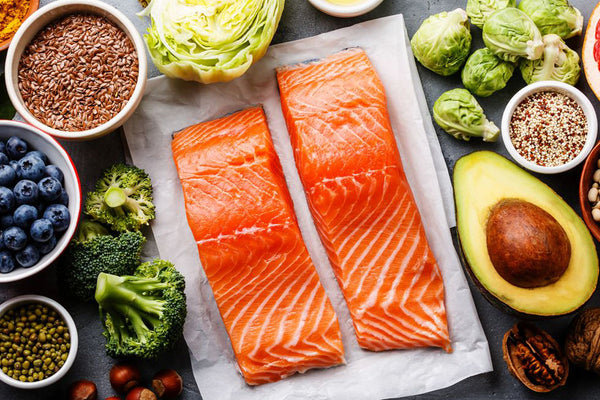What is a Pescatarian Diet?
A pescatarian diet is one in which a person consumes primarily a vegetarian diet while allowing for the consumption of fish and shellfish. Pescatarians do not consume red meat (beef, pork, elk, bison, etc.) or poultry (chicken, duck, goose, etc.).
However, they may also consume dairy or eggs periodically.
The term pescatarian is a combination of “pesce” (the Italian word for fish) and vegetarian. It first debuted “officially” in the early 1990s, though people have probably been eating this way for decades. They just weren’t “identifying” themselves by how they ate.
It’s also worth mentioning that pescatarian may also be spelled "pescetarian;" however, the meaning is still the same.
And, in the scientific literature (research studies), pescatarian diets can often be found listed under the description "pesco-vegetarian.”[1]
Why Do People Follow a Pescatarian Diet?
There are quite a few reasons why an individual would opt to forego red meat and other manner of land-faring, animal-based proteins and only utilize seafare (and the occasional hit of dairy or eggs) as their source of protein.
For starters, many individuals are concerned about the ethics of how their food is raised. Pescatarians, by and large, opt for wild fish and avoid all manner of farm-raised sea and land-faring animals.
Some of the ethical reasons pescatarians cite as to why they avoid meat are:
- Inhuman factory farming practices
- Inadequate working conditions for individuals on factory farms
- Opposition to the killing of animals
Another major reason an individual may choose to adopt a plant-based diet that also includes small amounts of seafood is environmental concerns.
It’s commonly believed that raising livestock contributes significantly to the creation of waste and greenhouse gasses. However, it’s typically thought that sourcing fish and other seafood (particularly wild-caught varieties) are less of a strain on natural resources and contribute less to humankind’s carbon footprint.
However, recent research is showing that it’s not the fact that animals are being raised on farms that’s the problem, it’s how they are being raised.
What are the Benefits of a Pescatarian Diet?
The pescatarian diet is viewed by many experts as one of the healthiest diets an individual can follow. The reason for this is that pescatarian diets for the most part are really plant-heavy diets that supplement with fish and other seafood.
As we know, plant-based diets are bountiful in essential micronutrients, fiber, and antioxidants, which is why research has found that diets high in plant foods can help lower the risk of chronic diseases like diabetes, obesity, and heart disease.[4,5,6]
The added benefit of pescatarian diets is that the inclusion of fish and seafood makes it easier to hit one’s daily protein goals. It can be difficult for some individuals with higher protein requirements to obtain enough dietary protein from only plant sources while still keeping their total daily calorie intake in check.
Additionally, unlike other fad diets, pescatarian diets don’t restrict your intake of carbohydrates (including whole grains and gluten) nor do the place you on some absurdly low amount of calories.
One of the biggest benefits of the pescatarian diet (aside from the high fruit and veggie intake) is that its rich in omega-3 fatty acids.
We’ve discussed at length the importance of omega-3 fatty acids in the diet, due to their roles in reducing inflammation, supporting cardiovascular health and promoting greater cognitive function.[7]
Still, many individuals don’t get enough omega-3s in their diet and consume too many omega-6s -- an unfortunate by-product of eating too many packaged and processed goods that are made with refined vegetable oils.
Switching to a pescatarian diet (or at the very least eating a couple servings of fatty fish, such as salmon, each week) can do a world of good in tilt the omega-6:omega-3 ratio in your favor.
What Foods Can I Eat on a Pescatarian Diet?
Basically, all plant foods are allowed as are all manner of fish and other seafood as well as eggs and dairy.
Here is a more detailed list of what pescatarians can eat on the diet:
- Whole grains (wheat, barley, rye, spelt)
- Quinoa
- Green leafy vegetables (lettuce, spinach, kale, chard, etc.)
- Starchy vegetables (potatoes, squash, peas, etc.)
- Fruit (berries, bananas, apples, oranges, etc.)
- Legumes (red beans, black beans, peanuts, etc.)
- Nuts (almonds, pistachios, pecans, etc.)
- Seeds (sunflower, pumpkin, chia, etc.)
- Fish (cod, salmon, tuna, sardines, etc.)
- Shellfish (shrimp, crab, crawfish, lobster, oysters, etc.)
- Eggs
- Dairy (yogurt, milk, cottage cheese, cheese, etc.)
Foods Not Allowed on a Pescatarian Diet
- Beef
- Pork
- Bison
- Elk
- Venison
- Turkey
- Chicken
- Duck
Drawbacks of a Pescatarian Diet
It’s hard to find any tangible faults from a pescatarian diet. It doesn’t restrict any macronutrient (such as paleo, carnivore, or keto diets do), nor does it force you to count calories or overly restrict your daily calorie intake.
It does prohibit you from eating land-based animal proteins such as beef and poultry, but many of the same nutrients you can obtain from red meat and chicken, can be had from seafare animals as well.
That being said, there is one major concern of the pescatarian diet -- the potential for high intakes of mercury.
Certain species of fish, particularly the larger varieties (king mackerel, ahi tuna, swordfish, and orange roughy), may contain mercury and other toxins.[8]
Due to this concern, the FDA advises that the women and children to limit the consumption of these species to about twice per week.
The Bottom Line on Pescatarian Diets
The pescatarian diet is a plant-heavy diet that allows for the consumption of fish and other seafood as well as dairy and eggs.
Compared to many other fad diets, the pescatarian diet is one of the most well-balanced diets there is, not to mention one of the most nutrient-dense ones too!
People adopt a pescatarian diet for a number of reasons including ethics, environmental concerns, and health.
References
- Orlich MJ, Singh PN, Sabaté J, et al. Vegetarian dietary patterns and mortality in Adventist Health Study 2. JAMA Intern Med. 2013;173(13):1230–1238. doi:10.1001/jamainternmed.2013.6473
- Stanley, P. L., Rowntree, J. E., Beede, D. K., DeLonge, M. S., & Hamm, M. W. (2018). Impacts of soil carbon sequestration on life cycle greenhouse gas emissions in Midwestern USA beef finishing systems. Agricultural Systems, 162, 249–258. https://doi.org/https://doi.org/10.1016/j.agsy.2018.02.003
- "Salmon." The World's Healthiest Foods, www.whfoods.com/genpage.php?tname=foodspice&dbid=104.
- Key, T. J., Fraser, G. E., Thorogood, M., Appleby, P. N., Beral, V., Reeves, G., … McPherson, K. (1998). Mortality in vegetarians and non-vegetarians: a collaborative analysis of 8300 deaths among 76,000 men and women in five prospective studies. Public Health Nutrition, 1(1), 33–41.
- Tonstad S, Butler T, Yan R, Fraser GE. Type of vegetarian diet, body weight, and prevalence of type 2 diabetes. Diabetes Care. 2009;32(5):791–796. doi:10.2337/dc08-1886
- Rosell, M., Appleby, P., Spencer, E., & Key, T. (2006). Weight gain over 5 years in 21,966 meat-eating, fish-eating, vegetarian, and vegan men and women in EPIC-Oxford. International Journal of Obesity (2005), 30(9), 1389–1396. https://doi.org/10.1038/sj.ijo.0803305
- Danielle Swanson, Robert Block, Shaker A. Mousa, Omega-3 Fatty Acids EPA and DHA: Health Benefits Throughout Life, Advances in Nutrition, Volume 3, Issue 1, January 2012, Pages 1–7, https://doi.org/10.3945/an.111.000893
- Raimann, X., Rodriguez O, L., Chavez, P., & Torrejon, C. (2014). [Mercury in fish and its importance in health]. Revista medica de Chile, 142(9), 1174–1180. https://doi.org/10.4067/S0034-98872014000900012






